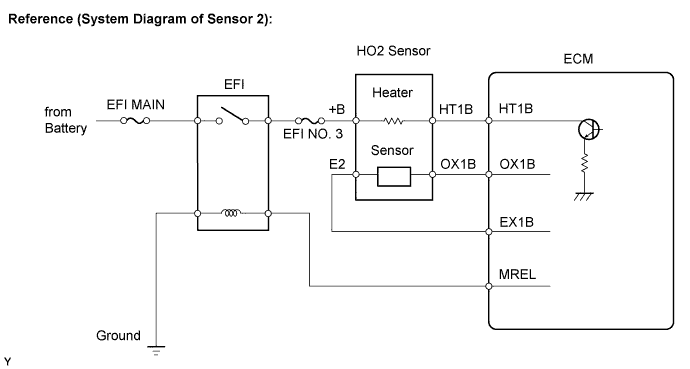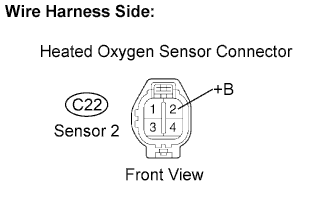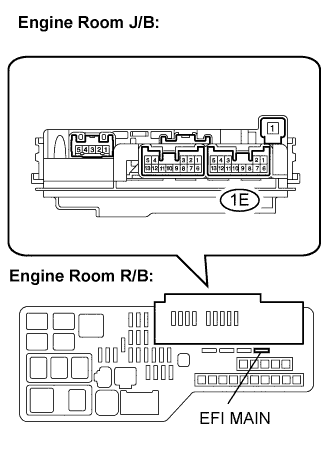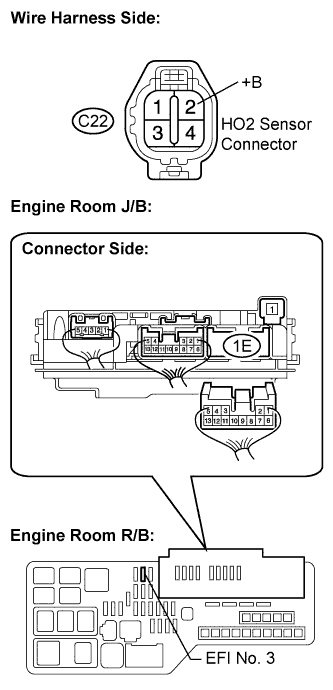INSPECT HEATED OXYGEN SENSOR (HEATER RESISTANCE)
CHECK TERMINAL VOLTAGE (+B OF HO2 SENSOR)
INSPECT ENGINE ROOM J/B (EFI RELAY, EFI MAIN FUSE)
CHECK HARNESS AND CONNECTOR (HO2 SENSOR - EFI RELAY)
CHECK HARNESS AND CONNECTOR (HO2 SENSOR - ECM)
CHECK WHETHER DTC OUTPUT RECURS
DTC P0037 Oxygen Sensor Heater Control Circuit Low (Bank 1 Sensor 2) |
DTC P0038 Oxygen Sensor Heater Control Circuit High (Bank 1 Sensor 2) |
DESCRIPTION
- Refer to DTC P0136 (Link).
- HINT:
- Sensor 2 refers to the sensor mounted behind the Three-Way Catalytic Converter (TWC) and located far from the engine assembly.
- When any of these DTCs are set, the ECM enters fail-safe mode. The ECM turns off the Heated Oxygen (HO2) Sensor heater in fail-safe mode. Fail-safe mode continues until the ignition switch is turned off.
- The ECM provides a pulse width modulated signal to the control circuit to adjust the current through the heater. The HO2 sensor heater circuit uses a relay on the +B side of the circuit.

| DTC No. | DTC Detection Condition | Trouble Area |
| P0037 | Heated Oxygen (HO2) sensor heater current less than 0.3 A (1 trip detection logic) |
|
| P0038 | Heated Oxygen (HO2) sensor heater current more than 2 A (1 trip detection logic) |
|
MONITOR DESCRIPTION
The sensing position of the Heated Oxygen (HO2) sensor has a zirconia element which is used to detect the oxygen concentration in the exhaust gas. If the zirconia element is at the appropriate temperature, and the difference between the oxygen concentrations surrounding the inside and outside surfaces of the sensor is large, the zirconia element generates voltage signals. In order to increase the oxygen concentration detecting capacity of the zirconia element, the ECM supplements the heat from the exhaust with heat from a heating element inside the sensor.- Heated oxygen sensor heater range check (P0037 and P0038):
The ECM monitors the current applied to the O2 sensor heater to check the heater for malfunctions. If the current is below the threshold value, the ECM determines that there is an open circuit in the heater. If the current is above the threshold value, the ECM determines that there is a short circuit in the heater.
The ECM constantly monitors the current applied to the heater. If the ECM detects an open or short circuit, the ECM turns the MIL on and sets a DTC.
If a malfunction is detected, the ECM cuts off the current applied to the heater.
Example:
The ECM sets DTC P0038 when the current in the HO2 sensor heater is more than 2 A. Conversely, when the heater current is less than 0.3 A, DTC P0037 is set.
WIRING DIAGRAM
Refer to DTC P0136 (CAMRY_ACV40 RM000000TEO05QX_08.html).CONFIRMATION DRIVING PATTERN
These DTCs are detected when the engine idles for 110 seconds or more.INSPECTION PROCEDURE
- HINT:
- Read freeze frame data using the intelligent tester. The ECM records vehicle and driving condition information as freeze frame data the moment a DTC is stored. When troubleshooting, freeze frame data can help determine if the vehicle was moving or stationary, if the engine was warmed up or not, if the air-fuel ratio was lean or rich, and other data from the time the malfunction occurred.
| 1.INSPECT HEATED OXYGEN SENSOR (HEATER RESISTANCE) |
Disconnect the C22 Heated Oxygen (HO2) sensor connector.
 |
Measure the resistance between the terminals of the HO2 sensor connector.
- Standard resistance:
Tester Connection Specified Condition HT1B (1) - +B (2) 11 to 16 Ω at 20°C (68°F) HT1B (1) - E2 (4) 10 kΩ or higher
Reconnect the HO2 sensor connector.
|
| ||||
| OK | |
| 2.CHECK TERMINAL VOLTAGE (+B OF HO2 SENSOR) |
Disconnect the C22 HO2 sensor connector.
 |
Turn the ignition switch to the ON position.
Measure the voltage between the terminal of the C22 HO2 sensor connector and body ground.
- Standard voltage:
Tester Connection Specified Condition +B (C22-2) - Body ground 9 to 14 V
Reconnect the HO2 sensor connector.
|
| ||||
| NG | |
| 3.INSPECT ENGINE ROOM J/B (EFI RELAY, EFI MAIN FUSE) |
Inspect the EFI MAIN fuse.
Remove the EFI MAIN fuse from the engine room J/B.
Measure the EFI MAIN fuse resistance.
- Standard resistance:
- Below 1 Ω
Reinstall the EFI MAIN fuse.
 |
Inspect the EFI relay.
Remove the engine room J/B from the engine room R/B.
Measure the EFI relay resistance.
- Standard resistance:
Tester Connection Specified Condition 1E-6 - 1E-12 10 kΩ or higher Below 1 Ω
(Apply battery voltage between terminals 1E-9 and 1E-11)
Reinstall the engine room J/B.
|
| ||||
| OK | |
| 4.CHECK HARNESS AND CONNECTOR (HO2 SENSOR - EFI RELAY) |
Inspect the EFI No. 3 fuse.
Remove the EFI No. 3 fuse from the engine room J/B.
Measure the EFI No. 3 fuse resistance.
- Standard resistance:
- Blow 1 Ω
Reinstall the EFI No. 3 fuse.
 |
Disconnect the C22 HO2 sensor connector.
Remove the engine room J/B from the engine room R/B.
Disconnect the 1E engine room J/B connector.
Measure the resistance between the terminals.
- Standard resistance (Check for open):
Tester Connection Specified Condition +B (C22-2) - Engine room J/B (1E-6) Below 1 Ω
- Standard resistance (Check for short):
Tester Connection Specified Condition +B (C22-2) or Engine room J/B (1E-6) - Body ground 10 kΩ or higher
Reconnect the HO2 sensor connector.
Reconnect the engine room J/B connector.
Reinstall the engine room J/B.
|
| ||||
| OK | ||
| ||
| 5.CHECK HARNESS AND CONNECTOR (HO2 SENSOR - ECM) |
Disconnect the C22 HO2 sensor connector.
 |
Disconnect the C24 ECM connector.
Measure the resistance between the terminals of the wire harness side connectors.
- Standard resistance (Check for open):
Tester Connection Specified Condition HT1B (C22-1) - HT1B (C24-47) Below 1 Ω
- Standard resistance (Check for short):
Tester Connection Specified Condition HT1B (C22-1) or HT1B (C24-47) - Body ground 10 kΩ or higher
Reconnect the HO2 sensor connector.
Reconnect the ECM connector.
|
| ||||
| OK | |
| 6.CHECK WHETHER DTC OUTPUT RECURS |
Connect the intelligent tester to the DLC3.
Turn the ignition switch to the ON position.
Turn the tester on.
Clear the DTCs (CAMRY_ACV40 RM000000PDK0D5X.html).
Start the engine.
Allow the engine to idle for 2 minutes or more.
Select the following menu items: Powertrain / Engine and ECT / DTC.
Read the DTCs.
- Result:
Display (DTC Output) Proceed to No output A P0037 or P0038 B
|
| ||||
| A | ||
| ||